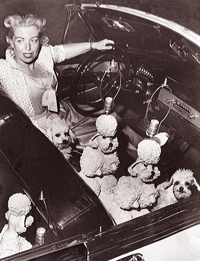
Interior design is the art and science of enhancing the interior of a building to achieve a healthier and more aesthetically pleasing environment for the people using the space. With a keen eye for detail and a creative flair, an interior designer is someone who plans, researches, coordinates, and manages such enhancement projects. Interior design is a multifaceted profession that includes conceptual development, space planning, site inspections, programming, research, communicating with the stakeholders of a project, construction management, and execution of the design.
Shabby chic is a style of interior design that chooses either furniture and furnishings for their appearance of age and signs of wear and tear or distresses new ones to achieve the same result. Unlike much genuine period décor, this style features a soft, pastel-colored, cottage look.

Florence Marguerite Knoll Bassett was an American architect, interior designer, furniture designer, and entrepreneur who has been credited with revolutionizing office design and bringing modernist design to office interiors. Knoll and her husband, Hans Knoll, built Knoll Associates into a leader in the fields of furniture and interior design. She worked to professionalize the field of interior design, fighting against gendered stereotypes of the decorator. She is known for her open office designs, populated with modernist furniture and organized rationally for the needs of office workers. Her modernist aesthetic was known for clean lines and clear geometries that were humanized with textures, organic shapes, and colour.

The Beverly Hills Hotel, also called the Beverly Hills Hotel and Bungalows, is located on Sunset Boulevard in Beverly Hills, California. One of the world's best-known hotels, it is closely associated with Hollywood film stars, rock stars, and celebrities. The hotel has 210 guest rooms and suites and 23 bungalows and the exterior bears the hotel's signature pink and green colors.

Robertson Boulevard is a street in Los Angeles, in the U.S. state of California, that also passes through the incorporated cities of West Hollywood, Beverly Hills, and Culver City.

Kelly Wearstler is an American designer. She founded her own design firm Kelly Wearstler Interior Design in the mid-1990s, serving mainly the hotel industry, and now designs across high-end residential, commercial, retail and hospitality spaces. Her designs for the Viceroy hotel chain in the early 2000s have been noted for their influence on the design industry. She has designed properties for clients such as Gwen Stefani, Cameron Diaz and Stacey Snider, and served as a judge on all episodes of Bravo's Top Design reality contest in 2007 and 2008.
Milo Ray Baughman, Jr. born in Goodland, Kansas, was a modern furniture designer.

Roy McMakin is a San Diego–based artist, designer, furniture maker, and architect.
Patricia Denise Guild OBE is a British designer and the founder and Creative Director of Designers Guild an international home and lifestyle company. She is known for her fabric and wallpaper collections and her work as a designer and manufacturer on a range of home interior products. She was awarded an OBE for services to interior design in 2008.

Plush Home, Inc., is an American company that sells home furnishings and functions as an interior-design firm. It was founded in 2003 by interior designer and furniture designer Nina Petronzio and her husband, martial art expert Steven Ho.
Norma Triangle is a residential neighborhood in West Hollywood, California. It encompasses the area bound by Doheny Drive and Beverly Hills on the west, Sunset Boulevard and Holloway Drive on the north, and Santa Monica Boulevard on the south. The small district has the shape of a right triangle.

Jerome Ackerman (1920–2019) and Evelyn Ackerman (1924–2012) were American industrial designers who jointly contributed to the aesthetic of California mid-century modern with their ceramics, wood carvings, mosaics, textiles, and enamels in home furnishings and architectural elements. The Ackermans sold their products through their companies Jenev and ERA Industries. Evelyn was an accomplished artist and an author of books on antique toys and dolls.
Donghia is an American brand of decoration for furniture, textiles, lighting, and accessories. Italian-American interior designer Angelo Donghia founded Donghia in 1968. It is currently owned by Kravet Inc.
Carol Kipling is an American interior designer based in Los Angeles and Seattle.
Frances Adler Elkins, was one of the twentieth century's most prominent interior designers. According to one magazine editor, she was "the first great California decorator". According to The New York Times, Elkins "pioneered vibrant interiors, in which solid historical references met effervescent modernist fantasy." She was the sister of the architect David Adler.

Greta Magnusson-Grossman was a Swedish furniture designer, interior designer, and architect. She was one of the few female designers to gain prominence during the mid-20th century architectural scene in Los Angeles. Her early exposure to European Modernism deeply influenced her later architectural work, seen as a synthesis of European ideals and the culture and lifestyle of Southern California.
Marmol Radziner is a design-build practice based in Los Angeles that was founded in 1989 by American architects Leo Marmol and Ron Radziner. The firm specializes in residential, commercial, hospitality, cultural, and community projects, and offers various design services, including architectural design, construction, landscape design, interior design, furniture design, jewelry design, and modern architecture restoration.
Ralph Pucci is an American mannequin designer, gallery owner and entrepreneur.
The Casa Encantada at 10644 Bellagio Road in Bel Air, Los Angeles is a large detached neoclassical style house completed in 1938. It was designed by James Dolena with interiors and furnishings by T. H. Robsjohn-Gibbings. It has twice established a record for the most expensive house sold in the United States.

The Paris Apartment is a style of interior design where the focus is on the French boudoir and all things related to and inspired by French design and decor. The style incorporates all aspects of design, from the ceiling to the floor, walls and trims to the furniture, light fixtures, curtains, soft furnishings, books, and color palette. The boudoir furnishings used include chaise lounges, vanities, slipper chairs, beds, daybeds, nightstands, chandeliers, sconces, lamps, paintings, armoires, dressers, mirrors, and rugs. Each is hand crafted and all have worn, original painted patinas, traditional French details, and generally range in time period from 18th Century France through the Art Deco period. Treating these historic items as important heirlooms and caring for them as stewards is as important as the aesthetics themselves. The style includes other international items with character to complete the look so that it can be seen both as a collection and as a style of decoration reflecting one's individuality.














